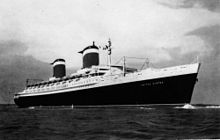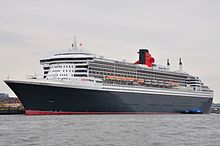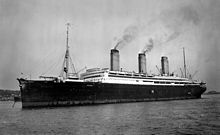Transatlantic liner

A transatlantic liner (often abbreviated Atlantic liner ) is generally understood to mean a passenger ship used in liner service that transports passengers and also freight (e.g. mail ) between Europe and America . In a narrower sense, the term mainly refers to those ships that operate or operate on the North Atlantic route between European ports and New York . Since the connection between the USA and Europe had been particularly important since the 19th century, the latest liners were often the largest and most technically innovative ships of their time.
With the development of the passenger aircraft from around 1950, the importance of regular shipping between Europe and America decreased. Modern cruise ships continue on the route, however, using the high prestige and popularity of many historical transatlantic liners (especially the Titanic ) for tourist purposes. The only ship that is technically designed as a transatlantic liner is now the Queen Mary 2 of the Cunard Line .
history
From the beginning to the First World War

With the rapid industrial boom in the United States from around the middle of the 19th century, the importance of the Atlantic traffic route between America and Europe grew by leaps and bounds: Its importance lay on the one hand in the increasing number of wealthy commercial travelers and on the other in the great waves of emigration in which Hundreds of thousands left their European homeland to start a new life in America. This development was supported by the construction of the steam engine, which enabled scheduled ship traffic independent of changing wind conditions and also allowed higher cruising speeds. The Canadian businessman Samuel Cunard offered the first liner services with initially small and spartan paddle steamers with auxiliary sails.
Initially unrivaled, a few years later the USA began to take part in the transatlantic competition with the Collins Line , which led to a rapid increase in ship sizes, the splendor of the furnishings and the speed of travel. With the increasing reliability of steam engines and the more efficient ship propeller compared to the paddle wheel , auxiliary sails became increasingly unnecessary from around 1880, which led to a further boost in the development of ship size. This progress only came to a temporary end with the outbreak of the First World War . Until then, in addition to Great Britain and the USA, Germany, France and Italy were among the nations that operated transatlantic shipping lines and fought increasing technical competition. The most famous ships of the early 20th century included, for example, the RMS Lusitania and her sister ship RMS Mauretania , the RMS Olympic and the German Imperator .
These ships were having dimensions of approximately 250 meters in length, a BRT No. of from about 35,000 to 50,000 and a capacity of several thousand passengers formidable technical projects and figurehead of the industrial skills of their nations. They were therefore associated with a prestige that is barely comprehensible today and with great public attention. Since the largest and most modern liners represented the latest technology, these ships were often considered unsinkable - a myth that was only shaken in 1912 by the sinking of the Titanic . The tragedy of the Lusitania , which was torpedoed by a submarine off Ireland in 1915 and killed 1200 people with it, finally ended the first major chapter of transatlantic passenger shipping.
The prime of the 1920s and 1930s


After the war, passenger shipping on the Atlantic recovered only slowly. Only with the upswing of the 1920s were major new buildings tackled again. The greatest technical innovation was the oil-firing system , which replaced the coal-firing ships that were standard practice until 1914 . This noticeably increased the efficiency of the ship's engines, which enabled even higher cruising speeds. In place of the emigrant class (" intermediate deck ") came the tourist class, which offered comfortable but inexpensive crossings for the ever-growing number of vacationers. The innovative newbuildings of the time included the French Île de France from 1927 and the German sister ships Bremen and Europa from 1929. Their interior furnishings in particular set new standards: while older ships tried to imitate historical styles, the newer liners developed their own interior design which was heavily influenced by the style of Art Deco .
The climax of this development was French Normandy , which from 1935 caused a sensation both with its size (for the first time more than 300 m in length; more than 80,000 GRT) and with its extraordinarily spacious interior. In response to this, the British Cunard Line completed the Queen Mary and Queen Elizabeth in the mid and late 1930s , which, although they reached similar sizes, had a much more conservative design. The outbreak of World War II in 1939 ended this era of transatlantic liners before even larger ships could be built.
Renaissance in the 1950s and decline in the 1960s

After the Second World War, liner shipping on the North Atlantic recovered one last time: the two Cunard ships, known for short as "the Queens", were joined by the spectacular United States , which is still the fastest passenger ship of all time. and the French France , plus liners from Germany, Sweden and the Netherlands. In Italy, too, elegant and luxurious transatlantic steamers like the Michelangelo were put into service until the mid-1960s . Despite all their technical capabilities, these ships were ultimately unable to prevail against the increasing scheduled air traffic, which took only a few hours from Europe to America instead of the four days that a crossing took. At the end of the 1960s, the regular service of the Atlantic liners declined more and more until it was discontinued in the mid-1970s; only the Stefan Batory (until 1987) and the Queen Elizabeth 2 (until 2004) continued to operate on the North Atlantic route.
The whereabouts of the ships and today's situation

Numerous liners retired from regular service were converted into cruise ships in the 1970s and some were still in service until the mid-2000s. However, with the increasing emergence of modern and ever larger cruise ships and the associated changing comfort demands of passengers, the former transatlantic liners have been displaced more and more. Many of the ships were ultimately decommissioned because they could no longer be operated economically due to their outdated steam turbine drive or because the machines became more and more vulnerable to repair after decades of operation. Others were withdrawn from the market because they did not meet the stricter safety regulations for SOLAS 2010 and the shipping companies were reluctant to undertake expensive modifications. High steel prices also contributed to the fact that, especially in the 2000s, most of the remaining former liners ended up in the scrapping yards. Today there are only five original historical transatlantic liners left in the world: The Great Britain , the Queen Mary , the Rotterdam and the Queen Elizabeth 2 , which have been preserved as museum ships and floating hotels, as well as the United States , which has been in operation for years and is threatened with decay . Stockholm is still active as a cruise ship - although it has been rebuilt beyond recognition and is no longer recognizable as a previous liner . All other ships have now been scrapped, provided they have not been lost in a ship accident. The only ship today that is in transatlantic service is the Queen Mary 2, which was commissioned in 2004 by the traditional British shipping company Cunard. The construction of the Queen Mary 2 was specially designed for the rough conditions of the North Atlantic and the Atlantic crossings it regularly operates are explicitly referred to by the shipping company not as cruises, but as scheduled liner trips.
The technical development that the transatlantic liners had undergone was enormous: it was not until 1996 that the volume of the Queen Elizabeth was exceeded, and the length record of the France only in 2003.
Others
- The Blue Ribbon , the imaginary award for the fastest ship on the North Atlantic route, was an extremely prestigious advertisement for the shipping companies, which therefore constantly strived for their ships to travel at high speeds. Particularly noteworthy is the Mauretania , completed in 1907 , which was able to hold its record until 1929 - the maiden voyage of the new Bremen . The last recipient of the Blue Ribbon is the United States , which is the fastest passenger ship ever built with a maximum speed of over 38 knots and an engine power of more than 240,000 hp.
- In the first class in particular, the large transatlantic liners achieved an enormous level of luxury from around 1900 at the latest, which could compete with the best grand hotels on land. Amenities that were still unusual on land at the time (such as elevators ) were a matter of course on the big steamers. Suites with several hundred square meters of living space and huge rooms that stretched over several decks soon became standard. This splendor of the equipment contributed significantly to the prestige and level of awareness of the transatlantic liners.
- All other large passenger ships currently in service are actually cruise ships, which means that they do not follow a regular timetable, even if they occasionally cross the Atlantic .
- The classic colors of the Atlantikliner (black hull and white superstructure) had a pragmatic background: Up until the First World War, almost all ships on this route were fired with coals that were stored in bunkers on the sides of the hull. The openings through which these were filled were just above the waterline . When the coal was poured in, coal dust was deposited in the entire area of these openings. The black color scheme was intended to make these traces of dust less prominent and was retained even after the coal-powered ships. The black hull color remained predominant for decades; only after the Second World War were isolated ships given a white hull.
Well-known transatlantic liners
- Crown Prince Wilhelm
- Lusitania (sunkby a German submarine in 1915)
- Mauretania
- France (scrapped in Dunkirk in 1934)
- Olympic (scrapped 1935)
- Titanic (sunk 1912)
- the ships of the Imperator- class
- Europe
- Bremen
- Normandy (burnt out in New York in 1942)
- Queen Mary
- Queen Elizabeth (burned out off Hong Kong in 1972)
- United States (located in the USA)
- America (the wreck lay off Fuerteventura for a long time and soon became a tourist attraction)
- France , scrapped in 2008.
- Stefan Batory (scrapped 2000)
- Queen Elizabeth 2
- Queen Mary 2 (only temporarily in the transatlantic service)
literature
- Robert D. Ballard , Ken Marschall : Lost Liners - From the Titanic to Andrea Doria - the glory and decline of the great luxury liners . Wilhelm Heyne Verlag GmbH & Co., Munich 1997, ISBN 3-453-12905-9 (English: Lost Liners: From the Titanic to the Andrea Doria. The ocean floor reveals its greatest lost ships. Translated by Helmut Gerstberger).
Movie
- Mathias Haentjes, director: ocean liners - golden years. Documentation about the era of the Atlantik-Liner, Germany, 2019, Radio Bremen , 52 min. (Image and film material about "Titanic", " Britannic " (wreck), from Cherbourg from Gare Maritime , from the Hapag-Hallen in Cuxhaven, to " Queen Mary 2 ", " Normandie ", " United States " - Philadelphia, " Ex-Astoria " - the oldest traveling pass.ship in this category. Information from the broadcaster arte , accessed on Feb. 27, 2020)



